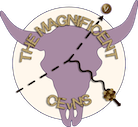Magnificent CEvNS School
The CEvNS Neutrino School will be held before the Magnificent CEvNS workshop, from Thursday June 5 to Saturday June 7, 2025, at the Brazilian Centre for Physics Research (CBPF). The school is aimed at student and postdoctoral researchers working on experimental and theoretical low-energy neutrino physics. The goal is to gain a profound understanding of neutrino physics, especially CEvNS, neutrino detection concepts, and data analysis. No pre-knowledge is needed for participation. The programme will be divided into two parts: lectures and hands-on projects.
Please note that the in-person registration starts at 8:30 on 5 June and the lectures start at 9:00 BRT. The lectures will also be transmitted over zoom (see the connection link in the left-side menu).
| Thursday | Friday | Saturday | |
| 09:00 - 10:00 | Lecture 1 | Lecture 1 | Lecture 2 |
| 10:00 - 11:00 | Lecture 3 | Lecture 3 | Lecture 3 |
| 11:00 - 11:30 | Coffee | Coffee | Coffee |
| 11:30 - 12:30 | Lecture 1 | Lecture 2 | Lecture 2 |
| 12:30 - 14:00 | Lunch | Lunch | Lunch |
| 14:00 - 15:30 | Project | Project | Discussion |
| 15:30 - 16:00 | Coffee | Coffee | |
| 16:00 - 17:30 | Project | Project |
School lectures programme:
- Basic aspects of neutrino physics - Diego Aristizabal
- Neutrino detection at low energies - Raimund Strauss
- Confidence intervals in particle physics - Dario Rodrigues
The projects are designed to gain insight into experimental work in hardware and data analysis and theoretical work in calculations. On the final day of the school, the projects will be presented and discussed. Students can choose one of the following projects:
- Numerical implementation of the CEvNS cross-section - Diego Aristizabal
- Skipper-CCDs performance and data analysis - Dario Rodrigues
- Constraining BSM models with CEvNS data and exclusion limits - Yuber Perez-Gonzalez
The CEvNS Neutrino School lectures and hands-on activities will take place in the lecture halls and labs of the Brazilian Centre for Physics Research (CBPF).
Lecture 1: Basic Aspects of Neutrino Physics
Diego Aristizabal
I will discuss a few aspects of electroweak theory relevant for neutrino scattering on different targets. The presentation will follow historical developments starting with the discovery of the neutron, the establishment of Fermi beta theory and finishing with the SM electroweak sector. A few aspects of effective theories will be covered. And an explicit calculation of the CEvNS cross section, using the hadron current multipole expansion, will be discussed.
Lecture 2: Neutrino detection at low energies
Raimund Strauß
In these lectures, I will discuss key milestones in neutrino physics, from the first detections to current large-scale experiments like DUNE. I will then present the main detector technologies used in neutrino research and the background challenges they face. Finally, I will review a decade of CEvNS experiments, from COHERENT to recent developments in CONUS.
Lecture 3: Confidence intervals in particle physics
Dario Rodrigues
This three-lecture series will explore the construction and interpretation of confidence intervals within the context of particle physics. We will begin by defining the likelihood function and highlighting its central role in statistical inference. Through a concrete example, we will examine how the likelihood depends on the number of observed events, with special attention to the challenges and appropriate strategies in the low-statistics regime typical of particle physics experiments. We will then review various methods for constructing confidence intervals, comparing their assumptions and practical applications. Finally, we will discuss the connection between the likelihood function and the least-squares method, and how a quantity following a chi-squared distribution can be used to assess the significance of results or to set exclusion limits.
Project 1: Numerical implementation of the CEvNS cross section
Diego Aristizabal
In the first part of this project nuclear form factor parametrizations will be discussed. That discussion will then be followed by the determination of neutrino fluxes from pion decay-at-rest and from nuclear reactors. The final part of the project will involve a full numerical implementation of the CEvNS cross section and the calculation of the event rate in both, fixed target and reactor facilities.
Project 2: Skipper-CCDs performance and data analysis
Dario Rodrigues
This two-session course will provide an in-depth exploration of Skipper-CCD detector performance and the techniques used to analyze their data. We will begin by reviewing the concept of noise in CCD detectors and how the Skipper architecture enables significant improvements in readout noise. Participants will learn how to quantify this noise using real images. We will then survey the various sources of single-electron events, and use real data to determine the dark current of the sensors and other contributions to the single-event background. The course will include a detailed study of sensor defects, such as hot pixels and hot columns, as well as the challenges posed by Charge Transfer Inefficiency and partial charge collection. Students will learn how to identify these effects and account for them in data analysis. A key focus will be the relationship between the event size and its depth within the sensor, and how this correlation can be exploited to define quality cuts. Finally, participants will gain hands-on experience in reconstructing energy spectra from real images, enabling them to set limits on the maximum number of events compatible with the targeted physical signals.
Project 3: Constraining BSM models with CEvNS data and exclusion limits
Yuber Perez-Gonzalez
In this project, we will explore recent results from the CONUS+ experiment and examine how they can be used to constrain physics beyond the Standard Model. In particular, we will focus on scenarios involving non-standard neutrino interactions, neutrino magnetic moments, and light mediators. Our analysis will be guided by the framework and methodology presented in https://arxiv.org/abs/2501.17843 , which provides a comprehensive study of these possibilities using CONUS+ data.
Invited Lecturers
Dario Rodrigues
Diego Aristizabal
Raimund Strauss
Yuber Perez-Gonzalez
School Organisers
Carla Bonifazi
Martin Makler
Irina Nasteva
